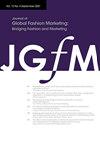The adoption of digital fashion as an end product: A systematic literature review of research foci and future research agenda
IF 5.5
Q2 BUSINESS
引用次数: 0
Abstract
With the advancement of 3D design software, “digital fashion” has evolved from a retail and design tool for physical fashion to a virtual-only end-product sold to consumers in wholly digital form. As many brands are now developing digital fashion end products as a new revenue stream, given its potential to reduce some levels of overconsumption of physical clothing, it warrants academic attention. However, the literature has predominantly defined digital fashion as a tool rather than an end-product, resulting in an incomplete definition of digital fashion. This hinders scholars’ ability to fully comprehend and explore this emerging product category. This article aims to synthesize the current marketing/management literature on digital fashion and investigate the theories, context, characteristics, and methodology of digital fashion as an end-product. This study contributes to the literature by providing a comprehensive industry-accepted definition of digital fashion within a conceptual framework, categorizing six different types of digital fashion end-products, and establishing a future research agenda that will lead to new research streams.采用数字时尚作为最终产品:对研究焦点和未来研究议程的系统文献综述
随着3D设计软件的发展,“数字时装”已经从实体时装的零售和设计工具演变为以完全数字化的形式出售给消费者的纯虚拟终端产品。鉴于数字时尚终端产品有可能在一定程度上减少对实体服装的过度消费,许多品牌现在都在开发数字时尚终端产品,作为一种新的收入来源,因此它值得学术界的关注。然而,文献主要将数字时尚定义为一种工具而不是最终产品,导致数字时尚的定义不完整。这阻碍了学者充分理解和探索这一新兴产品类别的能力。本文旨在综合当前关于数字时尚的营销/管理文献,并研究数字时尚作为最终产品的理论、背景、特征和方法。本研究通过在概念框架内提供一个全面的行业认可的数字时尚定义,对六种不同类型的数字时尚终端产品进行分类,并建立一个将导致新的研究流的未来研究议程,从而为文献做出贡献。
本文章由计算机程序翻译,如有差异,请以英文原文为准。
求助全文
约1分钟内获得全文
求助全文
来源期刊

Journal of Global Fashion Marketing
BUSINESS-
CiteScore
6.90
自引率
31.60%
发文量
34
期刊介绍:
The Journal of Global Fashion Marketing is a quarterly journal that publishes peer-reviewed conceptual and empirical papers and business cases of original works that significantly contribute to the overall advancement of marketing theory, research, and practice in fashion, design, and culture. JGFM endeavors to be a “global bridge” connecting marketing scholars and practitioners in fashion, design, and culture throughout the world. We publish high-quality scholarly articles on marketing written by contributors representing the leading academic authors. As we state on the cover of every issue, our positioning statement, our value added to the marketing scholar readership, is truly to “Bridge Fashion and Marketing” 1. Monitor and analyze global fashion marketing trends. 2. Generate and integrate new ideas and theories related to fashion, luxury, and culture marketing theory and practice. 3. Apply new research methods and techniques in fashion, luxury, and culture marketing. 4. Explore and disseminate cutting edge fashion marketing practices. JGFM welcomes manuscripts that provide fresh, innovative insight to any topic in the field of fashion, luxury, and culture marketing. Both conceptual and empirical works are valued, so long as the manuscript addresses substantive issues in marketing.
 求助内容:
求助内容: 应助结果提醒方式:
应助结果提醒方式:


